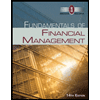
a)
To discuss:
Introduction:
Return: In financial context, return is seen as percentage that represents the profit in an investment.
b)
To discuss:
Average Rate of return.
Introduction:
Return: In financial context, return is seen as percentage that represents the profit in an investment.
c)
To discuss:
Standard deviation.
Introduction:
Return: In financial context, return is seen as percentage that represents the profit in an investment.
The standard deviation measures the volatility of the stock. It measures in absolute terms the dispersion of asset risk around its mean.
d)
To discuss:
Coefficient of variation
Introduction:
The coefficient of variation is an asset risk indicator that measures the relative dispersion. It describes the volatility of asset returns relative to its mean or expected return.
e)
To determine:
Investment decision
Introduction:
Risk: The risk can be defined as the uncertainty attached to an event such as investment where there is some amount of risk associated to it as there can be either gain or loss.
The coefficient of variation is an asset risk indicator that measures the relative dispersion. It describes the volatility of asset returns relative to its mean or expected return.
Want to see the full answer?
Check out a sample textbook solution
Chapter 8 Solutions
EBK PEARSON ETEXT PRINCIPLES OF MANAGER
 Fundamentals of Financial Management (MindTap Cou...FinanceISBN:9781285867977Author:Eugene F. Brigham, Joel F. HoustonPublisher:Cengage Learning
Fundamentals of Financial Management (MindTap Cou...FinanceISBN:9781285867977Author:Eugene F. Brigham, Joel F. HoustonPublisher:Cengage Learning Fundamentals of Financial Management (MindTap Cou...FinanceISBN:9781337395250Author:Eugene F. Brigham, Joel F. HoustonPublisher:Cengage Learning
Fundamentals of Financial Management (MindTap Cou...FinanceISBN:9781337395250Author:Eugene F. Brigham, Joel F. HoustonPublisher:Cengage Learning

